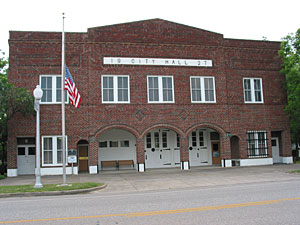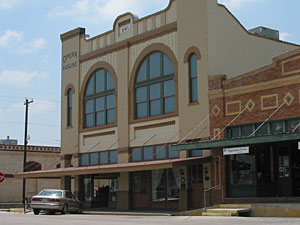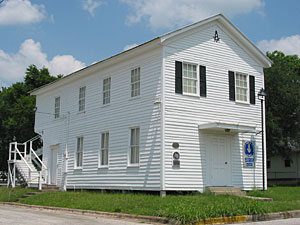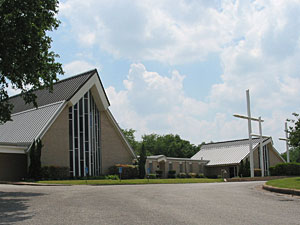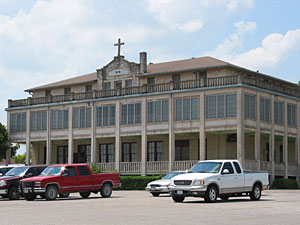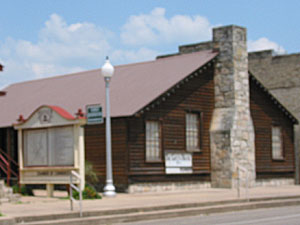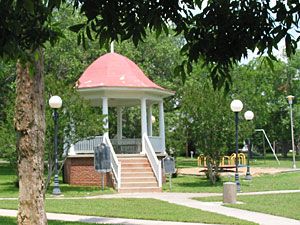From The Handbook of Texas Online:
Shiner is at the intersection of U.S. Highway 90A and State Highway 95, fourteen miles west of Hallettsville in western Lavaca County. In 1885 a post office called Half Moon was opened at a trading post near the present site of Shiner. When the San Antonio and Aransas Pass Railway came to the area in 1887 it bypassed Half Moon and built through land owned by Henry B. Shiner. Shiner donated 250 acres for a right-of-way and depot, and a town soon grew around the new transportation facilities. At first the community was called New Half Moon, but in 1888 its name was changed to Shiner. Shiner was incorporated in 1890, and L. P. Amsler was elected the first mayor. Czech and German immigrants soon became the dominant ethnic groups, and Shiner developed a cohesive Czech community through social organizations such as the National Sokol Society and the Slavonic Benevolent Order of the State of Texas. The population was reported at 2,074 in 1990 and 2,070 in 2000. The town supports a weekly newspaper, the Gazette, which was established in 1892. The most important agricultural products are dairy and beef cattle, cotton, and corn. Shiner has industries that manufacture wire, racks, dye, and tool plating. In 2002 the Spoetzl brewery, the sole producer of Shiner Beer, distributed their products in Texas and in twenty-two other states.
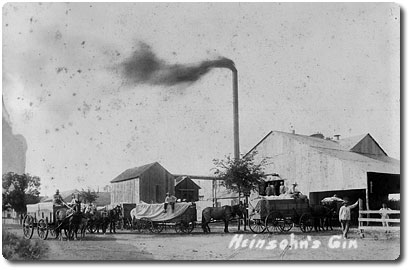
August Heinsohn Cotton Gin
contributed by Holly Heinsohn
Cotton in Shiner
contributed by Will Beauchamp
Historical Markers
|
Shiner Originated as German-Czech community of Half Moon, located west of present town. When the San Antonio and Aransas Pass Railroad came through in 1887, citizens moved to rail line, where H. B. Shiner, Victoria landowner, had given a townsite. Shiner was developed by cattlemen. Industries include brewery, wire works. City has museum. [1970] |
|
Shiner Opera HouseWilliam Wendtland (1856-1951) and Louis Wagener (1855-1936) built this structure in 1895. William Koch (1857-1928) enlarged the building with a rear addition in 1915. "The Opera House Saloon" and later other businesses occupied the lower floor. The opera house, located on the top floor, was the site of theatrical productions, social gatherings, dances, political rallies, and lodge meetings. Until the 1920s, the opera house was Shiner's main public auditorium. Recorded Texas Historic Landmark - 1979 |
|
Masonic Lodge BuildingMoved to this site, 1889, by David Kokernot, the builder. Given to Methodist church and Masonic Lodge. First local Sunday School was held here. In 1914 church was relocated. Entire hall is now owned by Masons. Recorded Texas Historic Landmark, 1967 |
|
First Methodist Church of ShinerThe Methodist Episcopal Church, South, of Shiner, Texas, was organized on November 1, 1887, in the office of L. P. Amsler, Shiner's first mayor. The Rev. C. C. Armstrong presided over the first service. In 1889 local rancher David Kokernot donated a small building to the community which was relocated to a town lot deeded to the church by the Shiner Townsite Company. The upper floor of the building housed a Masonic Lodge and the ground floor was used for services of the Methodist congregation. Eliza Amsler Welhausen formed a Sunday school in 1890. The original Masonic Lodge/church building was relocated and a new sanctuary was erected in 1914. The congregation began as a mission church and continued to be served by circuit preachers on a part-time basis until 1950 when a full-time pastor was appointed. By that time the congregation had formed a Vacation Bible School and a women's society. In 1954 the congregation was recognized as the outstanding rural church of the Southwest Methodist Conference. A new three-level complex, built here in 1961 on 6.4 acres donated by the Welhausen Land and Cattle Company, represents the congregation's three distinct fields of activity: worship, education, and fellowship. Sesquicentennial of Texas Statehood 1845-1995 |
|
Saints Cyril and Methodius Catholic ChurchEarly German and Czech settlers in this area of Lavaca County attended Catholic worship services in private homes or at churches in Hallettsville or Moulton until 1890, when a new mission was established in Shiner by the Rev. John Anthony Forest. The new congregation was named for 9th-century Greek Missionaries Cyril and Methodius, who converted Slovakian-Moravian central Europeans to Christianity. The members acquired two acres of land at this site in 1891, and a frame sanctuary was completed in May of that year. In February 1892 a tornado caused extensive damage to the original church structure, but it was rebuilt on a larger scale. Designated a parish in 1912, the growing congregation soon needed larger facilities. This structure, designed by F. Wahrenburger, was built in 1920-21 by volunteer laborers led by the Rev. F. X. Wolf. An outstanding example of the Romanesque revival style of architecture, it features stained glass windows imported from Munich, Germany; cut stone detailing in the pinnacles and buttresses; an arcaded front portico; and a soaring, square tower with octagonal spire. Listed in the National Register of Historic places since 1983, it also features a magnificent painted interior. Recorded Texas Historic Landmark - 1990 |
|
Saint Ludmila's AcademyThe first Catholic school in Shiner was built in 1896 by Scherbohm and Mewes, contractors. The two story French style frame building housed two classrooms, a dining room and kitchen on the first floor, and a residence for the Sisters on the second floor. Named Saint Ludmila's Academy in honor of a Slavic saint, the school opened in February 1897 and was operated by the Sisters of the Incarnate Word and Blessed Sacrament religious order in the state of Texas. The co-educational boarding and day school enrolled fifty-seven students the first year. Courses included German and Czech language; music courses featured piano, guitar, and mandolin. In 1902 two years of high school were added to the elementary grades. In 1916 a new structure was built to meet increased enrollment. In 1928 a four-year high school was incorporated, and the school received the designation of an academy. After 1939, no pupils were accepted as boarders. An elementary school was built in 1951, and a gymnasium, auditorium and cafeteria were added to the campus. In 1963 the Shiner Parish erected St. Paul High School. The educational complex is known as the Shiner Catholic School. (1997) |
|
Spoetzl BreweryBuilt by the Shiner Brewing Association, a stock company of local men. Sold in April 1915 to Kosmas Spoetzl (1873-1950), native of Bavaria and former operator of a brewery in Cairo, Egypt. This plant remained open in 1918-33 (prohibition era), making "Near Beer" and ice. The owner's daughter, "Miss Cecelie", joined staff in 1922. (She became only woman in U.S.A. to be sole owner of a brewery in 1950.) A nephew, August Haslebeck, joined in 1934; granddaughter Rosa, in 1964. In family over 50 years, the plant retains historic name, although sold in 1966 to new owners. |
|
Kaspar Wire WorksFounded as outgrowth of an 1895 invention that used smooth wire discarded when barbed wire fencing was introduced in this area. August Kaspar, son of a Swiss Lutheran missionary to Texas, salvaged some of the plain wire and made a corn shuck basket for home use. A neighbor saw and bought the basket. Soon Kaspar disposed of his baskets as rapidly as he could make and put them to use in his own barn. In 1898 he began the full-time manufacture of wire baskets and horse muzzles. His backyard shop was equipped with little more than a pair of pliers and his inventive genius. A rented wagon was the original Kaspar show room. Arthur H. Kaspar, son of the founder, purchased the business in 1924. In 1949 a grandson, Don G. Kaspar, joined the organization. Kaspar Wire Works has progressed to assembly-line manufacturing of nationally and internationally distributed goods -- including display racks, baskets, newspaper racks, wire shelving and many other products. The growth and success of Kaspar Wire Works was officially recognized in 1967 by the bestowal of the first annual Governor's Expansion Award under the auspices of the Texas Industrial Commission. [1970] |
|
William Green HouseWilliam Green and wife India, pioneers from Kentucky, bought this land and erected a house here in 1853. Style is typical of era, with central "dog trot" hall dividing two main rooms. William Green, Jr., and wife Julia, who lived here 8 years, ran the Winnton post office and a general store. From 1869 to 1889 the store was a social center for this rural area. Property is now used as camp by Boy Scouts of America. Recorded Texas Historic Landmark -- 1970 |
|
Welhausen Park BandstandBuilt in 1913 on land donated by Confederate veteran and local leader Capt. Charles Welhausen (1835-1916), this bandstand has been a center of cultural and social events in Shiner. Funds for construction were raised by the local women's civic club, which chose a design typical of park architecture in the Victorian age. The bandstand was used for ice cream socials, bazaars, Sunday afternoon concerts, patriotic events and moonlight picnics. The structure has been kept in its original condition except for the replacement of its wooden floor and steps. Captain Charles Welhausen(September 2, 1835 - November 3, 1916) A native of Hanover, Germany, Charles Welhausen immigrated to Texas with his parents, arriving at the Port of Galveston in 1843. They settled first at Cat Spring in Austin County, and later moved to High Hill in Fayette county, where Charles became a saddle maker. Enlisting in the Confederate army at the outbreak of the Civil War, Charles Welhausen served at Fort Brown and Fort Manhassett in Texas before taking part in the Battle of Calcasieu Pass in Louisiana in 1864. Cited for gallantry in action, he was promoted to captain. Returning to Fayette County after the war, Welhausen married Eliza Amsler in 1867. He served as county commissioner and justice of the peace, and was elected to represent Fayette County in the twenty-first Texas Legislature in 1888. In 1890 the Welhausens and their children moved to Shiner, where they purchased a ranch from H. B. Shiner. Charles Welhausen opened a bank and became a respected business and civic leader; Eliza Welhausen was an active lay leader in the Methodist church. Charles Welhausen purchased this site in 1911 and donated it to the city for a park. |
|
Ponton FamilyVirginians William (1772-1834) and Isabella (Moreland) Ponton came to Texas in 1829 from Missouri. With them were their children Andrew, Sarah Ann, and Mary Jane and son-in-law James Patrick. Their son Joel Ponton arrived in 1834. The families received land in DeWitt's colony. William Ponton was the first recorded settler killed by Comanche Indians in the area that became Lavaca County. Joel Ponton and a companion were attacked in the same area in 1840; Joel survived with two arrows in his back. Ponton Creek was named for William. The Pontons and their neighbors stood up against the Mexican Army in the Battle of Gonzales and later fled the area in "The Runaway Scrape" in the wake of Santa Anna's victory at the Alamo. After the Texan victory at the Battle of San Jacinto, they returned to rebuild their homes from almost nothing. They endured Indian attacks and lived through the eras of the Republic of Texas, statehood, the Civil War and Reconstruction. Exemplary pioneers, they were mothers and fathers, alcaldes, judges, tax collectors, commissioners, doctors, preachers, storekeepers, farmers, ranchers, and official peacemakers. The children and grandchildren of William and Isabella Ponton forged Lavaca County from a wilderness. The story of the Ponton family is a story of Texas. (1998) |
See Lavaca County Historical Markers page for other historical markers in the Shiner area.
